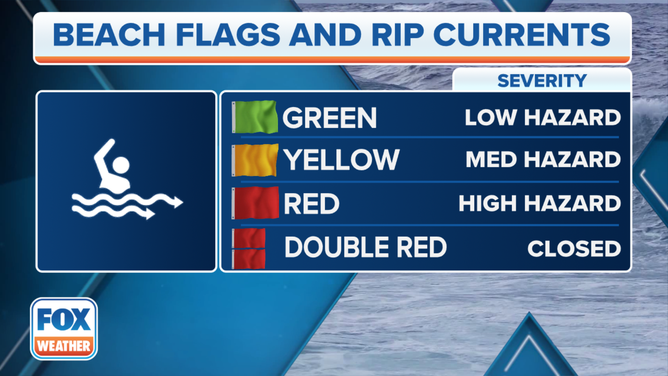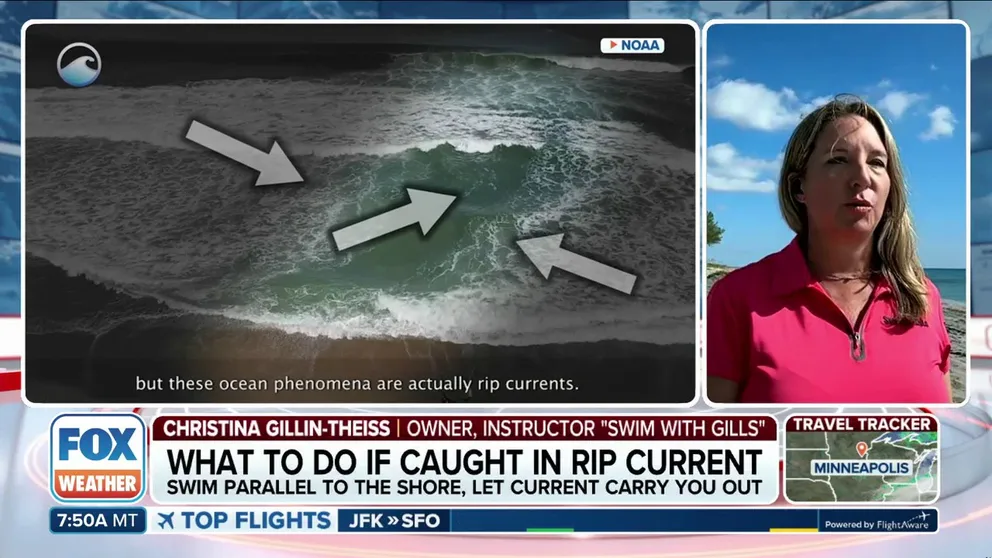Deadly rip current risk increases along US beaches after multiple swimmers drown ahead of 4th of July holiday
Continued warnings come after at least eight people have been killed by rip currents in Florida over the past several days.
Rip current risk remains high along US beaches
Numerous beaches from the Gulf Coast to the Northeast are seeing moderate and high rip current risks, and those conditions are expected to last into the weekend. FOX Weather Correspondent Brandy Campbell was in New Smyrna Beach, Florida, and has safety information from officials for anyone entering the water.
Temperatures are rising, and people are flocking to beaches to try and cool off as the Fourth of July holiday looms, but swimmers are being urged to be on the lookout for a hidden danger along the U.S. coastline that has already led to multiple deaths so far this summer – rip currents.
A rip current is a strong, narrow current of water that moves away from the shoreline and out to sea at a high rate of speed and can occur at any beach with breaking waves. Even the Great Lakes can experience rip currents.
Rip currents have already been reported along the U.S. coast from the Florida Panhandle through the mid-Atlantic and into the Northeast, and the FOX Forecast Center expects them to remain a potential problem through at least the weekend.
Deadly rip currents continue in Florida

(FOX Weather)
At least eight people have been killed by rip currents in Florida alone just in the past several days.
Officials said an Oklahoma teenager and four others died near Panama City Beach. A man in his early 20s drowned off the same beach on Sunday. A mother and father visiting Hutchinson Island near Port St. Lucie with their six children drowned when they were swept away by a rip current.
Rip currents claim two lives in Florida as family vacations along Hutchinson Island
The mother and father of six mostly teen children drowned Thursday after getting pulled out to sea in strong rip currents while on a family vacation in Florida.
Florida is seeing a continued high risk of rip currents along parts of the Panhandle, while the east coast of the Sunshine State from West Palm Beach to Jacksonville is seeing a moderate risk of rip currents.
That moderate risk of rip currents also extends to the north along the Georgia and South Carolina coasts.
The National Weather Service office in Tallahassee issued a Rip Current Statement, urging beachgoers to be vigilant.
"While weather will be nice for beachgoers, dangerous rip currents will lurk just below the surface, despite surf of only around two feet," the NWS said. "Beachgoers should take note of all beach flags and follow the orders of beach safety officials."
The NWS also urged visitors to swim near a lifeguard if possible.
FLORIDA'S BIGGEST WEATHER-RELATED KILLER LURKS ALONG BEACHES
Mid-Atlantic sees moderate risk of rip currents Wednesday

(FOX Weather)
Those heading to one of the pristine beaches along the North Carolina coast will also need to be on the lookout for rip currents, although the risk isn't as high as the Florida Panhandle.
There is a moderate risk of rip currents along Cape Hatteras and areas to the south, including Myrtle Beach in South Carolina.
HERE ARE THE MOST DANGEROUS BEACHES IN THE US ACCORDING TO RESEARCH

Know these rip current flags when you go to the beach.
(FOX Weather)
The NWS office in Newport/Morehead City in North Carolina issued a Beach Hazard Statement warning visitors to be mindful of rip currents. It included beaches from Cape Lookout to Surf City.
Swimmers at Northeast beaches also see high rip current danger

(FOX Weather)
NOAA AIMS TO KEEP BEACHGOERS SAFE WITH NEW LIFE-SAVING RIP CURRENT FORECAST MODEL
The risk of rip currents along beaches in the Northeast has increased since Tuesday.
There’s a moderate risk of rip currents along beaches in Delaware, including Rehoboth Beach and Bethany Beach.
To the north, there's a high risk of rip currents along the Jersey Shore and south-facing beaches on Long Island in New York, and Rip Current Statements have been issued.
DOWNLOAD THE FREE FOX WEATHER APP
In New York City, Brooklyn has also been included in the Rip Current Statement.
"Life-threatening rip currents are likely for all people entering the surf zone," the NWS said. "Anyone visiting beaches should stay out of the surf. Rip currents can sweep even the best swimmers away from shore into deeper water."
How to survive a rip current
How to survive a rip current
Do you know what to do if you find yourself caught in a rip current while swimming? Swim instructor and owner of Swim With Gills Christina Gillin-Theiss joined FOX Weather on Wednesday from Jupiter Island, Florida, to explain how you can stay safe and survive if you’re struggling in the water.
If you're swimming, and you feel yourself being pulled out into the open water, stay calm.
The rip current likely won't pull you under, it will just pull you away from the shoreline. While still terrifying, staying calm can mean the difference between life and death.
Try to float in the water. Fighting the current will only make you tired. Instead, swim out of the rip current by swimming parallel to the shore, and then follow the waves back to shore.


